Local Mechanical Properties and Microstructure of EN AW 6082 Aluminium Alloy Processed via ECAP–Conform Technique
Abstract
1. Introduction
2. Material and Methods
3. Results
3.1. Microstructure of Samples
3.2. Micro-Hardness Evaluation
3.3. Tensile Tests
4. Discussion
- Hall–Petch strengthening due to grain refinement;
- Increased density of statistical dislocations and geometrically necessary dislocations;
- Orowan strengthening.
5. Conclusions
- Even one pass through the ECAP–Conform tool can substantially refine the grain structure.
- This refinement is inhomogeneous; the conformed wire contains bigger grains situated in the center, surrounded by smaller ones.
- Local estimation of mechanical properties showed significant differences between central and peripheral parts of the conformed wire.
- These differences are very probably created by the dissimilar strain in the upper and bottom wire parts.
- Tests performed on transversal samples revealed negligible plastic anisotropy.
- The main strengthening mechanisms are grain size refinement and generation of geometrically necessary dislocations.
- Miniaturized tensile tests are an effective tool for the local estimation of mechanical properties.
Author Contributions
Funding
Acknowledgments
Conflicts of Interest
Appendix A. Tests Results
| Distance in Radial (R) Direction (mm) | |||||||||||||||||||
|---|---|---|---|---|---|---|---|---|---|---|---|---|---|---|---|---|---|---|---|
| 0.5 | 1.0 | 1.5 | 2.0 | 2.5 | 3.0 | 3.5 | 4.0 | 4.5 | 5.0 | 5.5 | 6.0 | 6.5 | 7.0 | 7.5 | 8.0 | 8.5 | 9.0 | 9.5 | |
| Vickers hardness, HV05 | |||||||||||||||||||
| IS | 114 | 115 | 115 | 116 | 116 | 116 | 114 | 116 | 116 | 116 | 116 | 116 | 116 | 116 | 118 | 116 | 115 | 116 | 116 |
| QS | 92.5 | 92.6 | 92.4 | 92.7 | 92.3 | 92.5 | 92.6 | 92.5 | 92.4 | 92.5 | 92.4 | 92.7 | 92.6 | 92.5 | 92.3 | 92.4 | 92.5 | 92.5 | 92.6 |
| ECS | 106 | 106 | 120 | 126 | 129 | 129 | 128 | 123 | 125 | 121 | 127 | 128 | 131 | 127 | 129 | 126 | 129 | 120 | 106 |
| Sample | E, GPa | YS, MPa | UTS, MPa |
|---|---|---|---|
| STT_IS_1 | 71.5 | 339.1 | 364.5 |
| MTT_IS_L_1 | 71.6 | 333.6 | 370.0 |
| MTT_IS_L_4 | 70.4 | 334.5 | 363.1 |
| Sample | E, GPa | YS, MPa | UTS, MPa |
|---|---|---|---|
| STT QS 1 | 66.7 | 140.7 | 254.7 |
| MTT_QS_L_1 | 68.2 | 144.3 | 257.0 |
| MTT_QS_L_4 | 65.2 | 147.6 | 250.3 |
| Specimen | E, GPa | YS, MPa | UTS, MPa |
|---|---|---|---|
| STT_ECS_1 | 65.1 | 371.6 | 393.6 |
| STT_ECS_2 | 71.2 | 391.5 | 398.4 |
| STT_ECS_3 | 73.8 | 375.8 | 387.4 |
| MTT_ECS_L_1 | 58.7 | 280.5 | 326.2 |
| MTT_ECS_L_2 | 56.7 | 351.6 | 371.7 |
| MTT_ECS_L_3 | 61.6 | 372.9 | 386.9 |
| MTT_ECS_L_4 | 60.8 | 380.2 | 391.8 |
| MTT_ECS_L_5 | 69.6 | 361.9 | 374.5 |
| MTT_ECS_L_6 | 61.9 | 380.6 | 400.0 |
| MTT_ECS_L_7 | 62.1 | 382.0 | 398.8 |
| MTT_ECS_L_8 | 62.4 | 389.4 | 398.9 |
| MTT_ECS_L_9 | 62.8 | 299.7 | 354.2 |
| MTT_ECS_T_4 | 58.8 | 377.7 | 394.4 |
| MTT_ECS_T_5 | 57.7 | 331.1 | 354.0 |
| MTT_ECS_T_6 | 60.7 | 375.7 | 398.5 |
References
- Valiev, R.; Islamgaliev, R.; Alexandrov, I. Bulk nanostructured materials from severe plastic deformation. Prog. Mater. Sci. 2000, 45, 103–189. [Google Scholar] [CrossRef]
- Zrník, J.; Dobatkin, S.V.; Fujda, M.; Džugan, J. Effect of Preliminary Treatment on Grain Refinement of Medium Carbon Steel Using ECAP at Increased Temperature. Mater. Sci. Forum 2010, 638, 2013–2018. [Google Scholar] [CrossRef]
- Estrin, Y.; Vinogradov, A. Extreme grain refinement by severe plastic deformation: A wealth of challenging science. Acta Mater. 2013, 61, 782–817. [Google Scholar] [CrossRef]
- Estrin, Y.; Janecek, M.; Raab, G.; Valiev, R.; Zi, A. Severe Plastic Deformation as a Means of Producing Ultra-Fine-Grained Net-Shaped Micro Electro-Mechanical Systems Parts. Met. Mater. Trans. A 2007, 38, 1906–1909. [Google Scholar] [CrossRef]
- Horita, Z.; Fujinami, T.; Langdon, T.G. The potential for scaling ECAP: Effect of sample size on grain refinement and mechanical properties. Mater. Sci. Eng. A 2001, 318, 34–41. [Google Scholar] [CrossRef]
- Horita, Z.; Fujinami, T.; Nemoto, M.; Langdon, T.G. Equal-channel angular pressing of commercial aluminum alloys: Grain refinement, thermal stability and tensile properties. Met. Mater. Trans. A 2000, 31, 691–701. [Google Scholar] [CrossRef]
- Xu, C.; Schroeder, S.; Berbon, P.B.; Langdon, T.G. Principles of ECAP–Conform as a continuous process for achieving grain refinement: Application to an aluminum alloy. Acta Mater. 2010, 58, 1379–1386. [Google Scholar] [CrossRef]
- Hu, J.; Zhang, W.; Fu, D.; Teng, J.; Zhang, H. Improvement of the mechanical properties of Al–Mg–Si alloys with nano-scale precipitates after repetitive continuous extrusion forming and T8 tempering. J. Mater. Res. Technol. 2019, 8, 5950–5960. [Google Scholar] [CrossRef]
- Ding, S.; Chang, C.P.; Kao, P. Effects of Processing Parameters on the Grain Refinement of Magnesium Alloy by Equal-Channel Angular Extrusion. Met. Mater. Trans. A 2009, 40, 415–425. [Google Scholar] [CrossRef]
- Seipp, S.; Wagner, M.F.-X.; Hockauf, K.; Schneider, I.; Meyer, L.W.; Hockauf, M. Microstructure, crystallographic texture and mechanical properties of the magnesium alloy AZ31B after different routes of thermo-mechanical processing. Int. J. Plast. 2012, 35, 155–166. [Google Scholar] [CrossRef]
- Bryla, K.; Dutkiewicz, J.; Malczewski, P. Grain refinement in AZ31 alloy processed by equal channel angular pressing. Arch. Mater. Sci. Eng. 2009, 40, 17–22. [Google Scholar]
- Jin, L.; Lin, D.; Mao, D.; Zeng, X.; Chen, B.; Ding, W. Microstructure evolution of AZ31 Mg alloy during equal channel angular extrusion. Mater. Sci. Eng. A 2006, 423, 247–252. [Google Scholar] [CrossRef]
- Vinogradov, A.; Estrin, Y. Analytical and numerical approaches to modelling severe plastic deformation. Prog. Mater. Sci. 2018, 95, 172–242. [Google Scholar] [CrossRef]
- Hodek, J.; Kubina, T. FEM Model and Experimental Production of Titanium Rods Using Conform Machine; TANGER: Ostrava, Czech Republic, 2013; pp. 347–351. [Google Scholar]
- Fakhretdinova, E.; Raab, G.; Ryzhikov, O.; Valiev, R.Z. Processing ultrafine-grained Aluminum alloy using Multi-ECAP-Conform technique. IOP Conf. Ser. Mater. Sci. Eng. 2014, 63, 012037. [Google Scholar] [CrossRef]
- Murashkin, M.; Sabirov, I.; Prosvirnin, D.; Ovid’Ko, I.; Terentiev, V.; Valiev, R.Z.; Dobatkin, S. Fatigue Behavior of an Ultrafine-Grained Al-Mg-Si Alloy Processed by High-Pressure Torsion. Metals 2015, 5, 578–590. [Google Scholar] [CrossRef]
- Raab, G.J.; Valiev, R.Z.; Lowe, T.C.; Zhu, Y. Continuous processing of ultrafine grained Al by ECAP–Conform. Mater. Sci. Eng. A 2004, 382, 30–34. [Google Scholar] [CrossRef]
- Xu, C.; Száraz, Z.; Trojanová, Z.; Lukáč, P.; Langdon, T.G. Evaluating plastic anisotropy in two aluminum alloys processed by equal-channel angular pressing. Mater. Sci. Eng. A 2008, 497, 206–211. [Google Scholar] [CrossRef]
- Trojanová, Z.; Džugan, J.; Halmešová, K.; Németh, G.; Minárik, P.; Lukáč, P.; Bohlen, J. Influence of Accumulative Roll Bonding on the Texture and Tensile Properties of an AZ31 Magnesium Alloy Sheets. Materials 2018, 11, 73. [Google Scholar] [CrossRef] [PubMed]
- Máthis, K.; Köver, M.; Stráská, J.; Trojanová, Z.; Džugan, J.; Halmešová, K. Micro-Tensile Behavior of Mg-Al-Zn Alloy Processed by Equal Channel Angular Pressing (ECAP). Materials 2018, 11, 1644. [Google Scholar] [CrossRef]
- Trojanová, Z.; Halmešová, K.; Džugan, J.; Palček, P.; Minárik, P.; Lukáč, P. Influence of strain rate on deformation behaviour of an AX52 alloy processed by equal channel angular pressing (ECAP). Lett. Mater. 2018, 8, 517–523. [Google Scholar] [CrossRef]
- Kubina, T.; Dlouhy, J.; Kövér, M.; Hodek, J. Study of Thermal Stability of Ultra Fine-Grained Commercially Pure Titanium Wire Prepared in Conform Equipment. Mater. Sci. Forum 2014, 782, 415–420. [Google Scholar] [CrossRef]
- Jirková, H.; Rubešová, K.; Konopík, P.; Opatová, K. Effect of the Parameters of Semi-Solid Processing on the Elimination of Sharp-Edged Primary Chromium Carbides from Tool Steel. Metals 2018, 8, 713. [Google Scholar] [CrossRef]
- Džugan, J.; Konopík, P.; Trojanová, Z.; Procházka, R. SPD Processed Materials Mechanical Properties Determination with the Use of Miniature Specimens. Mater. Sci. Forum 2016, 879, 471–476. [Google Scholar] [CrossRef]
- Konopík, P.; Džugan, J.; Procházka, R. Evaluation of Local Mechanical Properties of Steel Weld by Miniature Testing Technique; MS and T: Rolla, MO, USA, 2013; pp. 2404–2411. [Google Scholar]
- Džugan, J.; Konopík, P.; Procházka, R. Micro-Tensile test technique development and application to mechanical property determination. Small Spec. Test Tech. 2014, 6, 12–30. [Google Scholar] [CrossRef]
- Maleček, L.; Palán, J.; Nacházel, J.; Dlouhy, J. Influence of rotary swaging and subsequent age hardening on properties of EN AW 6082 aluminium alloy. IOP Conf. Ser. Mater. Sci. Eng. 2017, 179, 12049. [Google Scholar] [CrossRef]
- Salehi, M.S.; Anjabin, N.; Kim, H.S. Study of Geometrically Necessary Dislocations of a Partially Recrystallized Aluminum Alloy Using 2D EBSD. Microsc. Microanal. 2019, 25, 656–663. [Google Scholar] [CrossRef]
- Derakhshan, J.F.; Parsa, M.; Jafarian, H. Microstructure and mechanical properties variations of pure aluminum subjected to one pass of ECAP-Conform process. Mater. Sci. Eng. A 2019, 747, 120–129. [Google Scholar] [CrossRef]
- Dmitriev, A.I.; Nikonov, A.Y.; Shugurov, A.R.; Panin, A.V. The Role of Grain Boundaries in Rotational Deformation in Polycrystalline Titanium under Scratch Testing. Phys. Mesomech. 2019, 22, 365–374. [Google Scholar] [CrossRef]
- De Castro, V.; Leguey, T.; Muñoz, A.; Monge, M.; Pareja, R. Relationship between hardness and tensile tests in titanium reinforced with yttria nanoparticles. Mater. Sci. Eng. A 2005, 400, 345–348. [Google Scholar] [CrossRef]
- Ashby, M.F. The deformation of plastically non-homogeneous materials. Philos. Mag. 1970, 21, 399–424. [Google Scholar] [CrossRef]
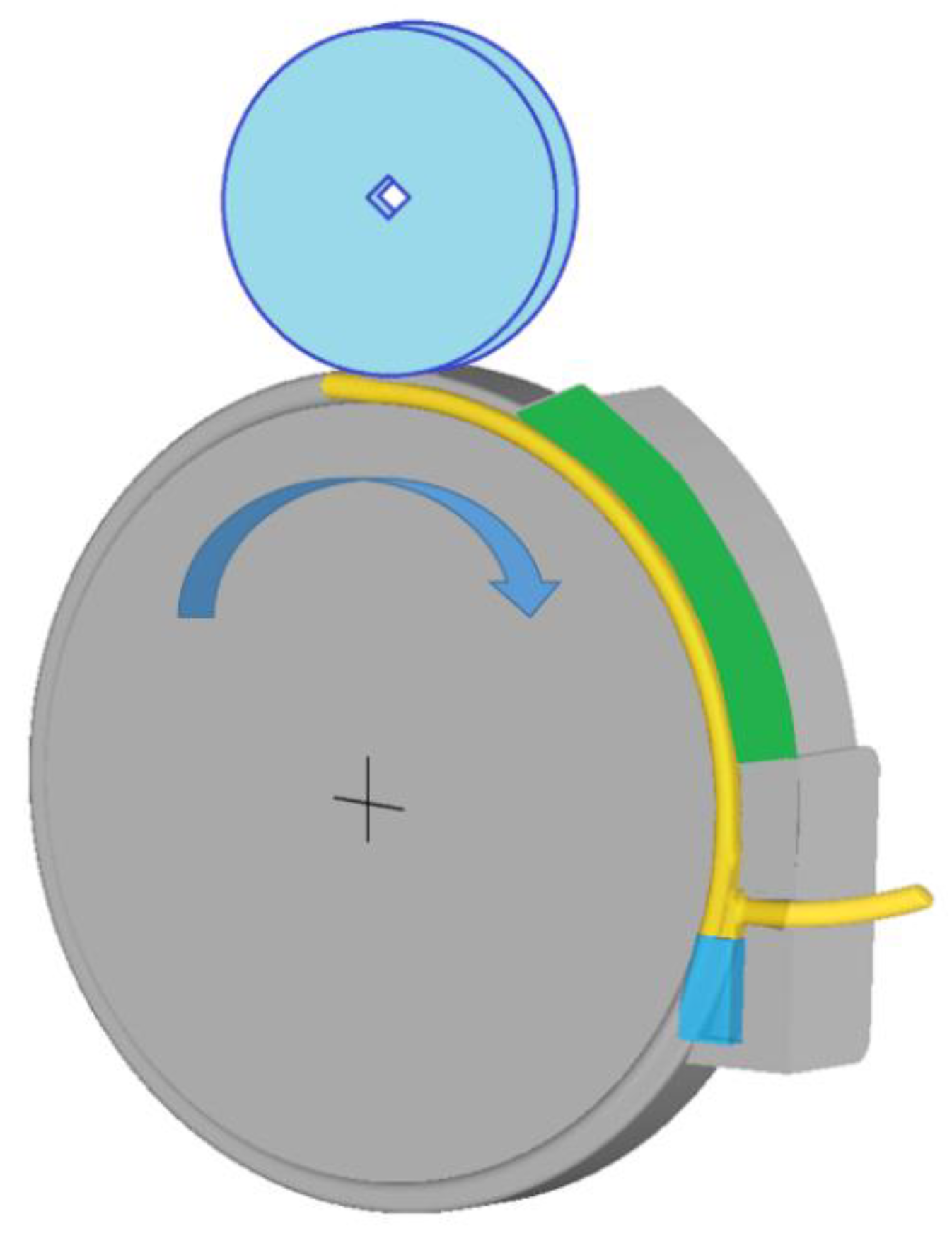
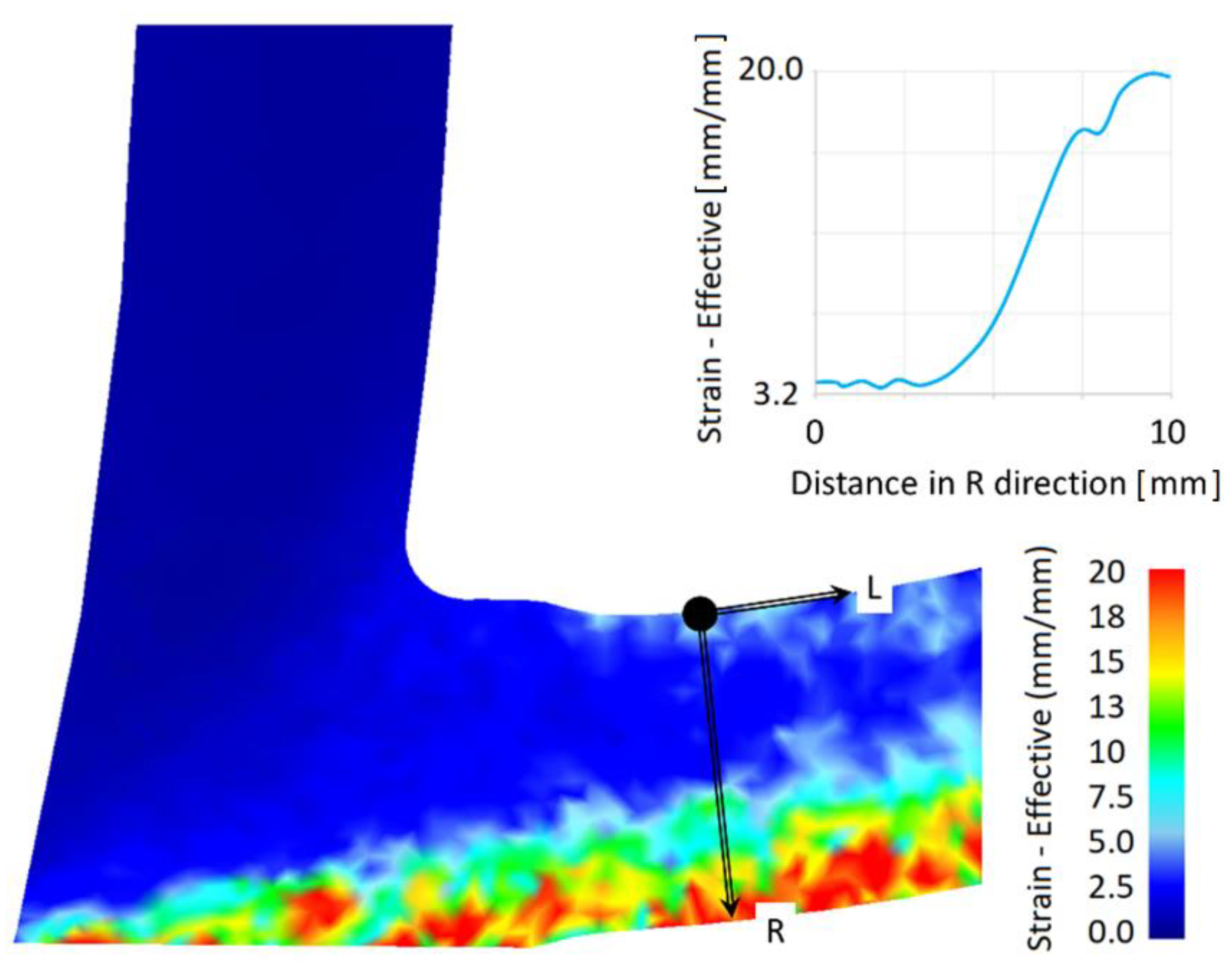
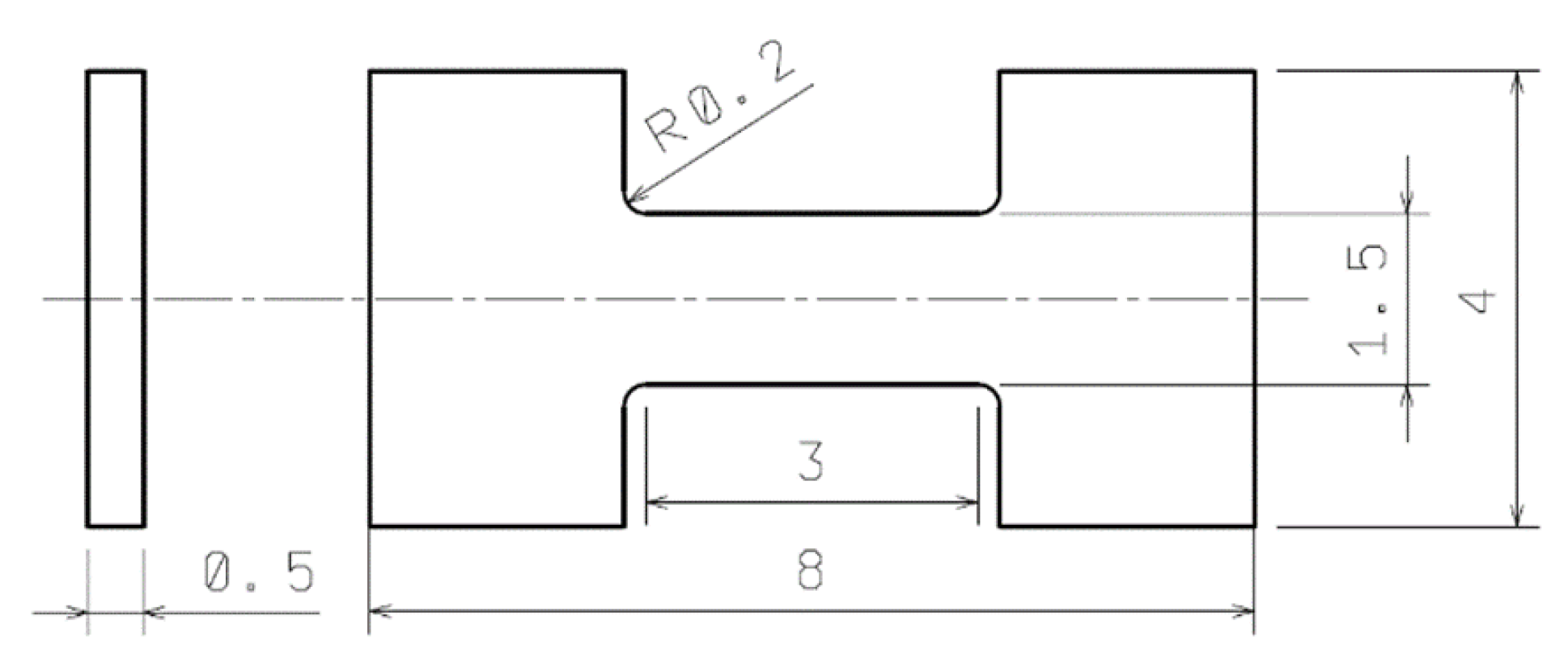

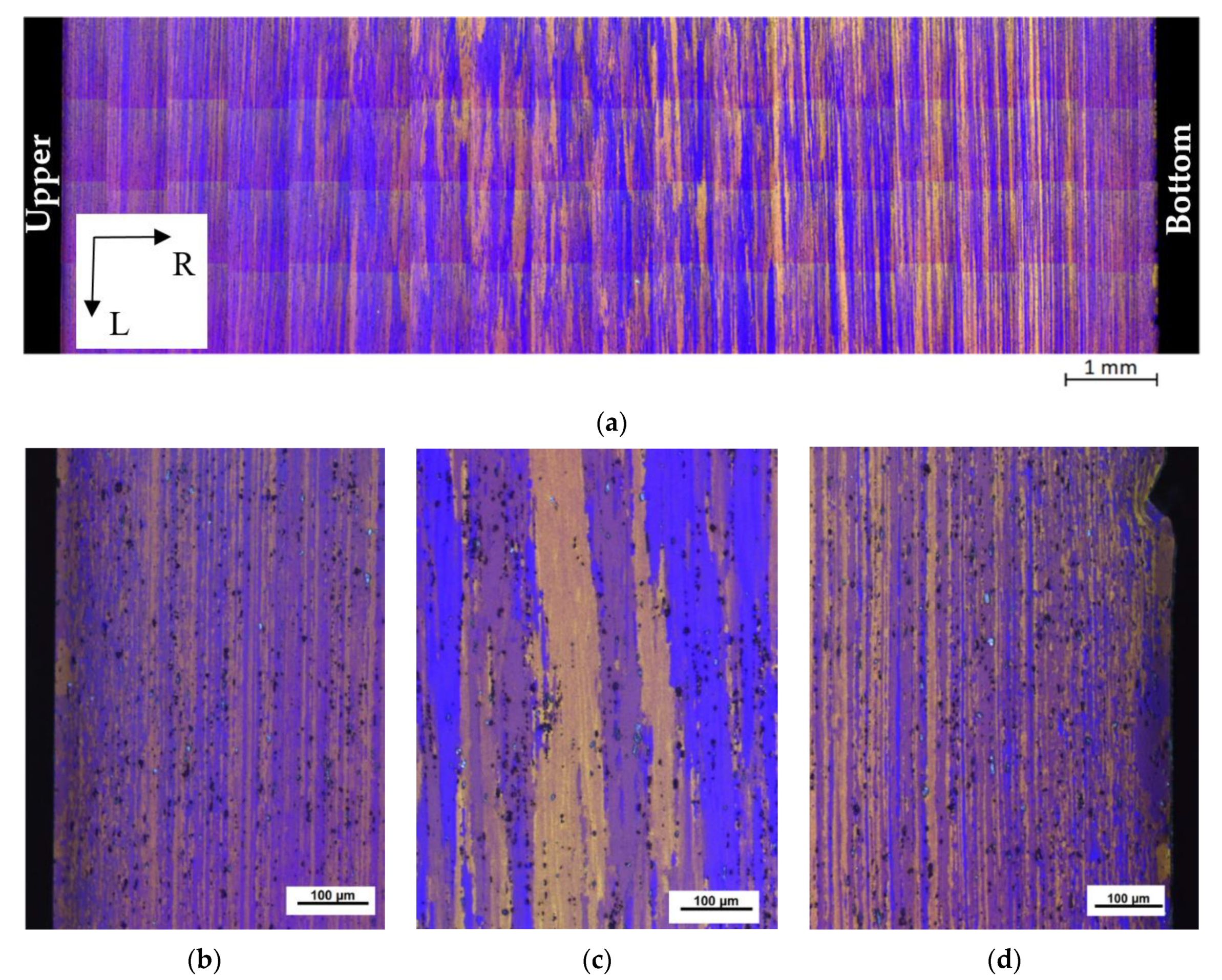
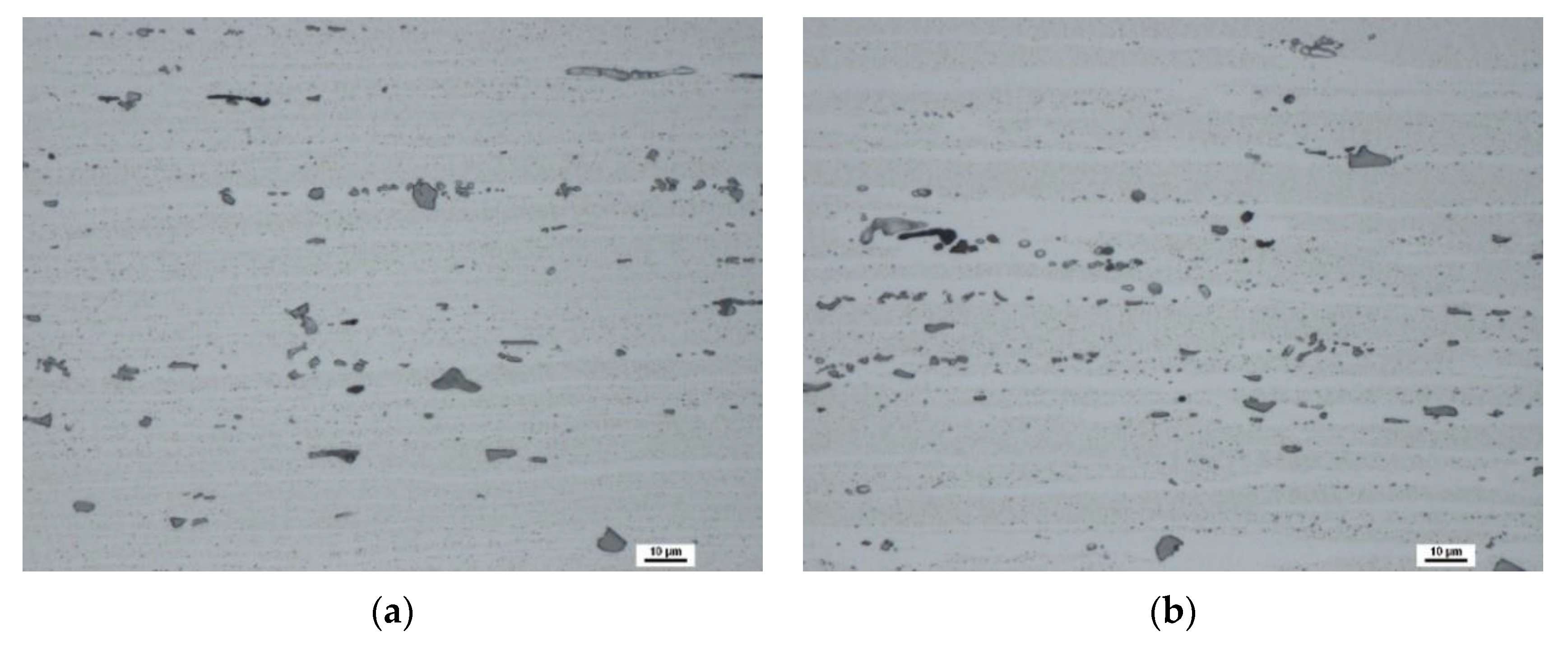
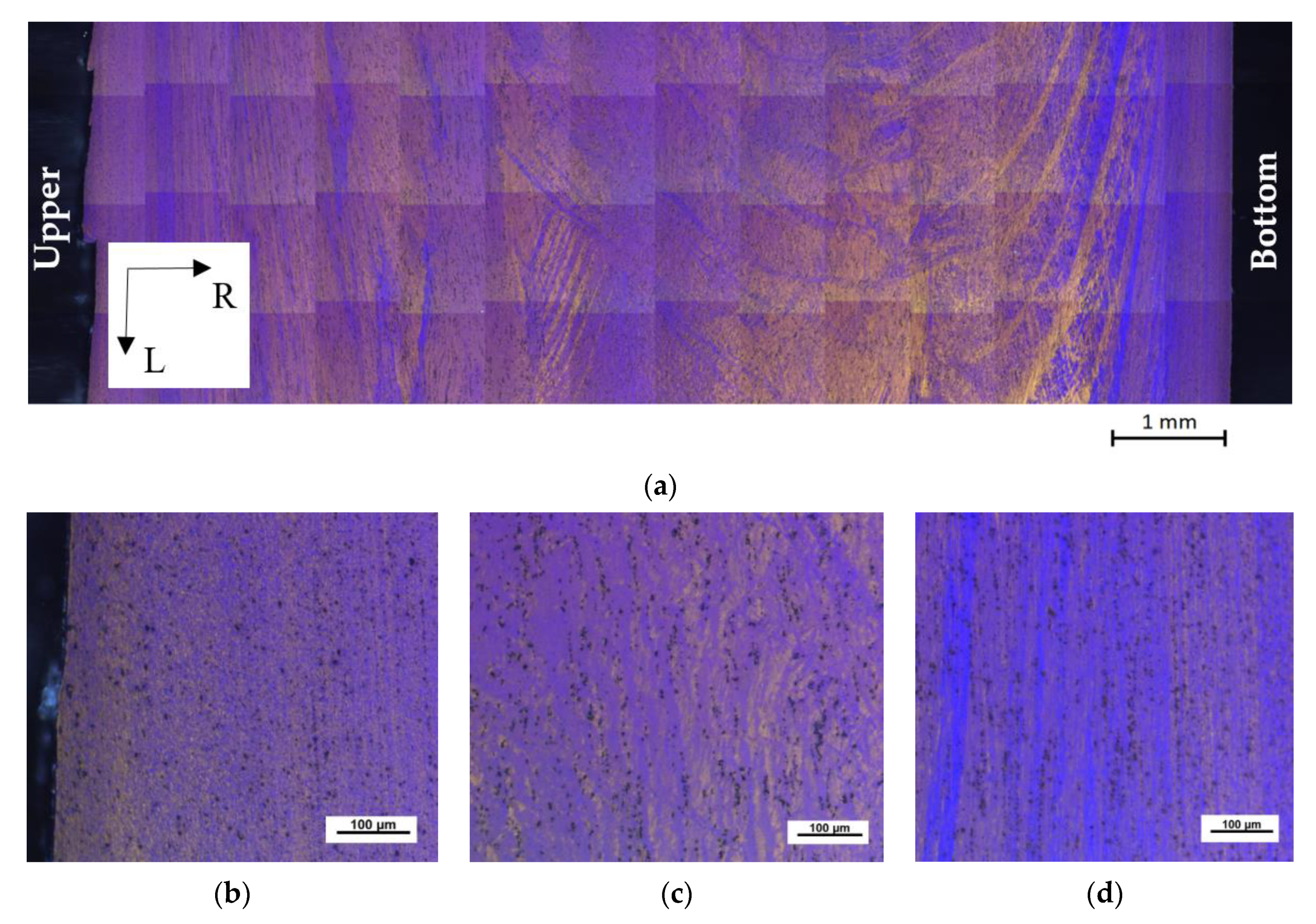
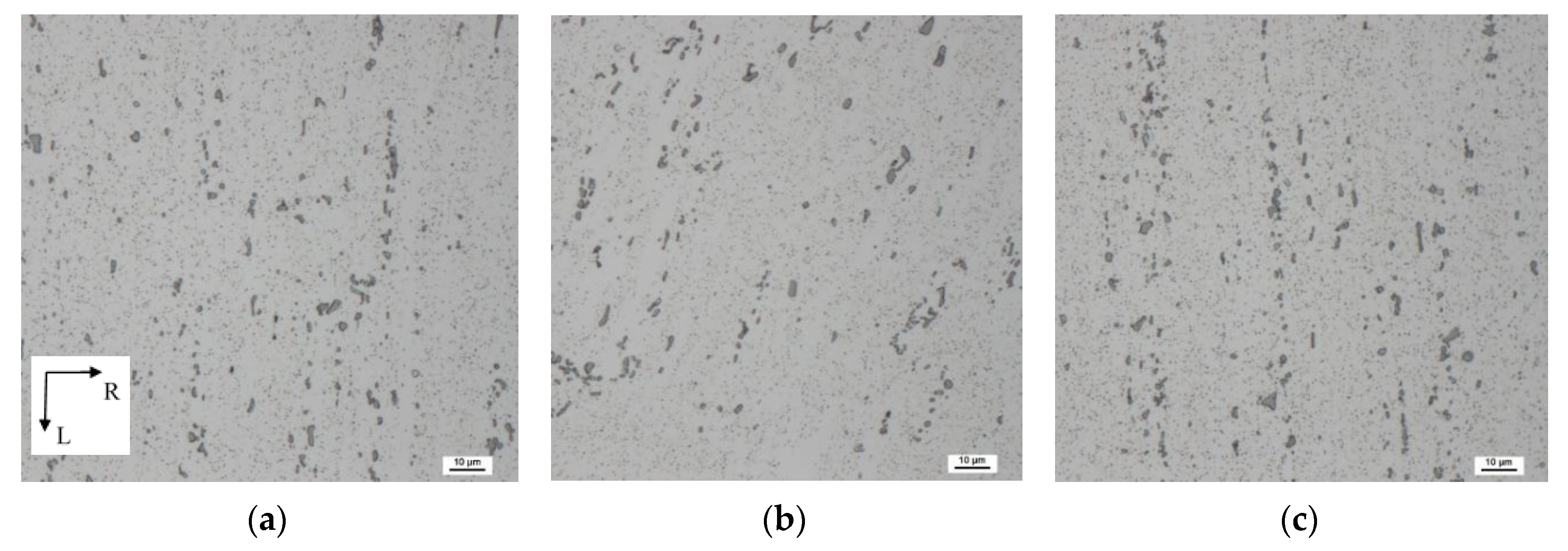
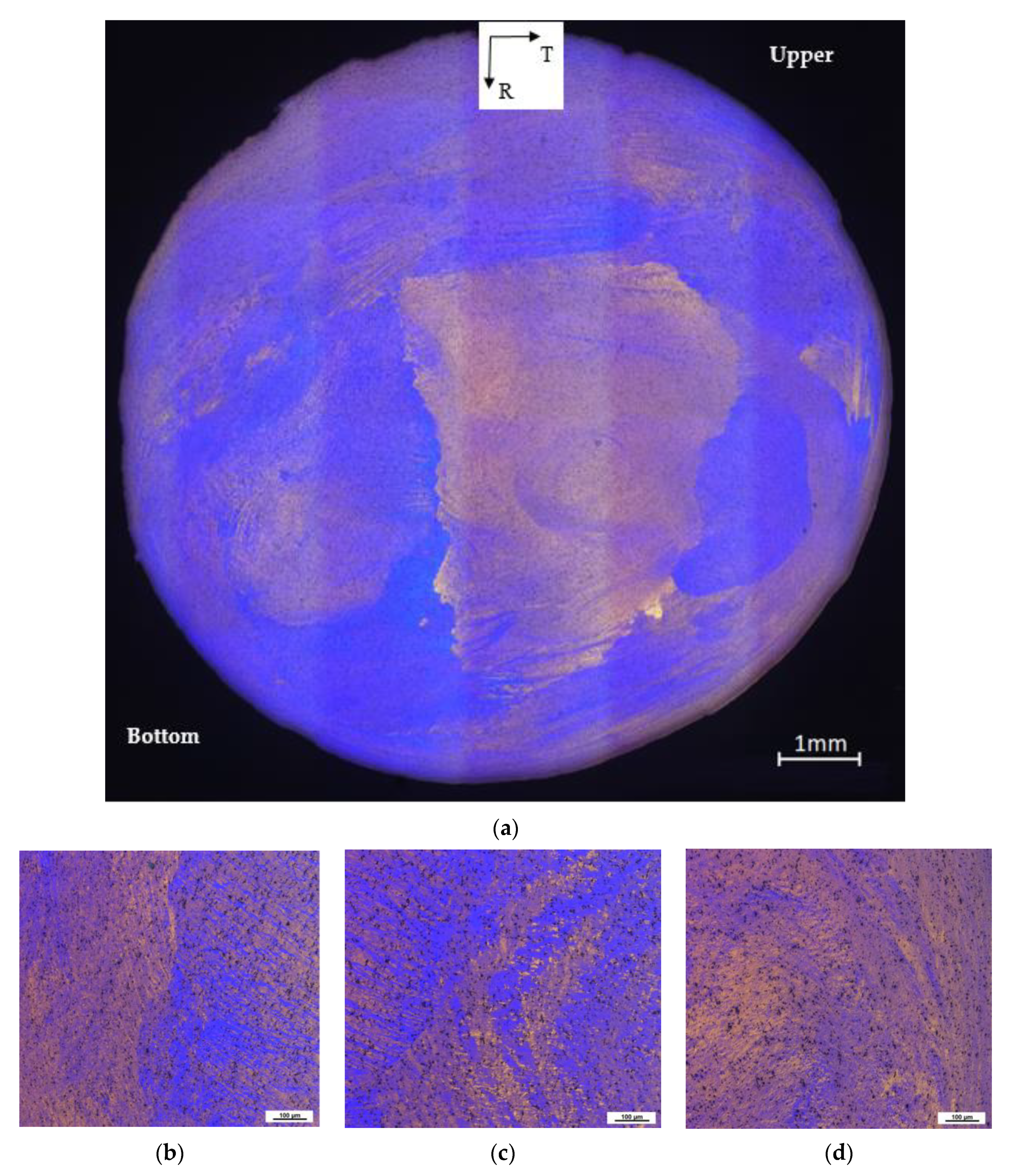
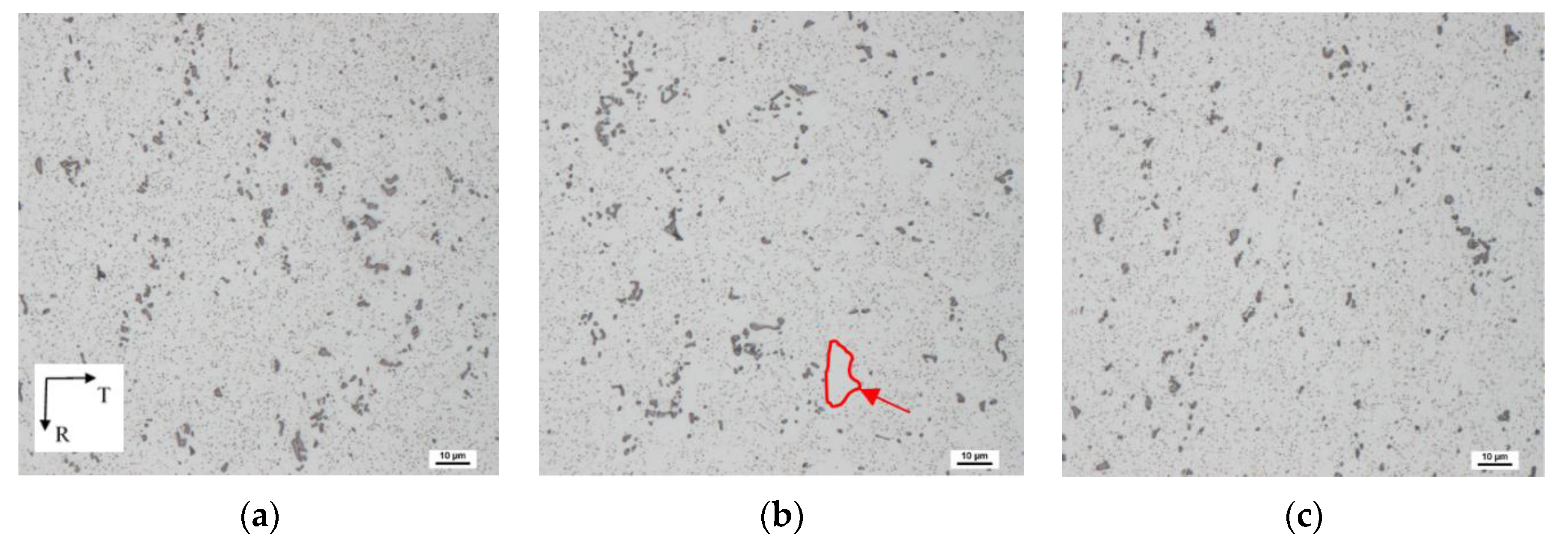
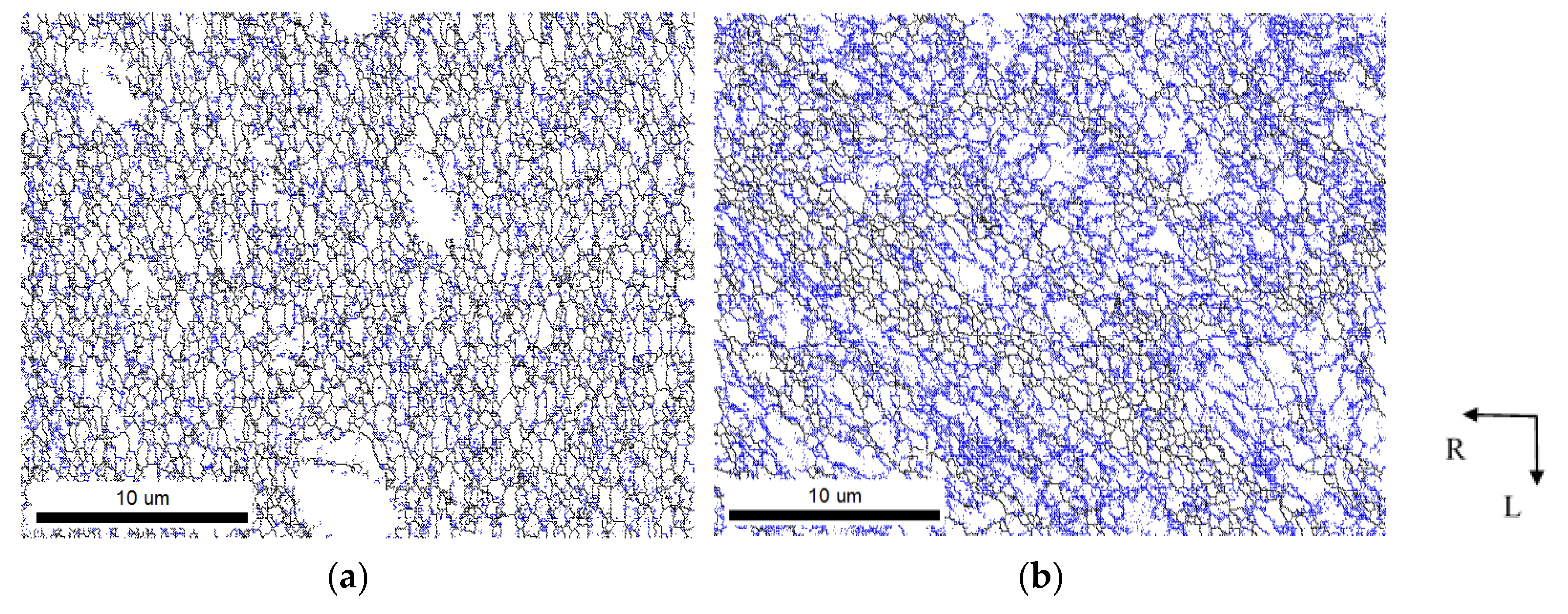
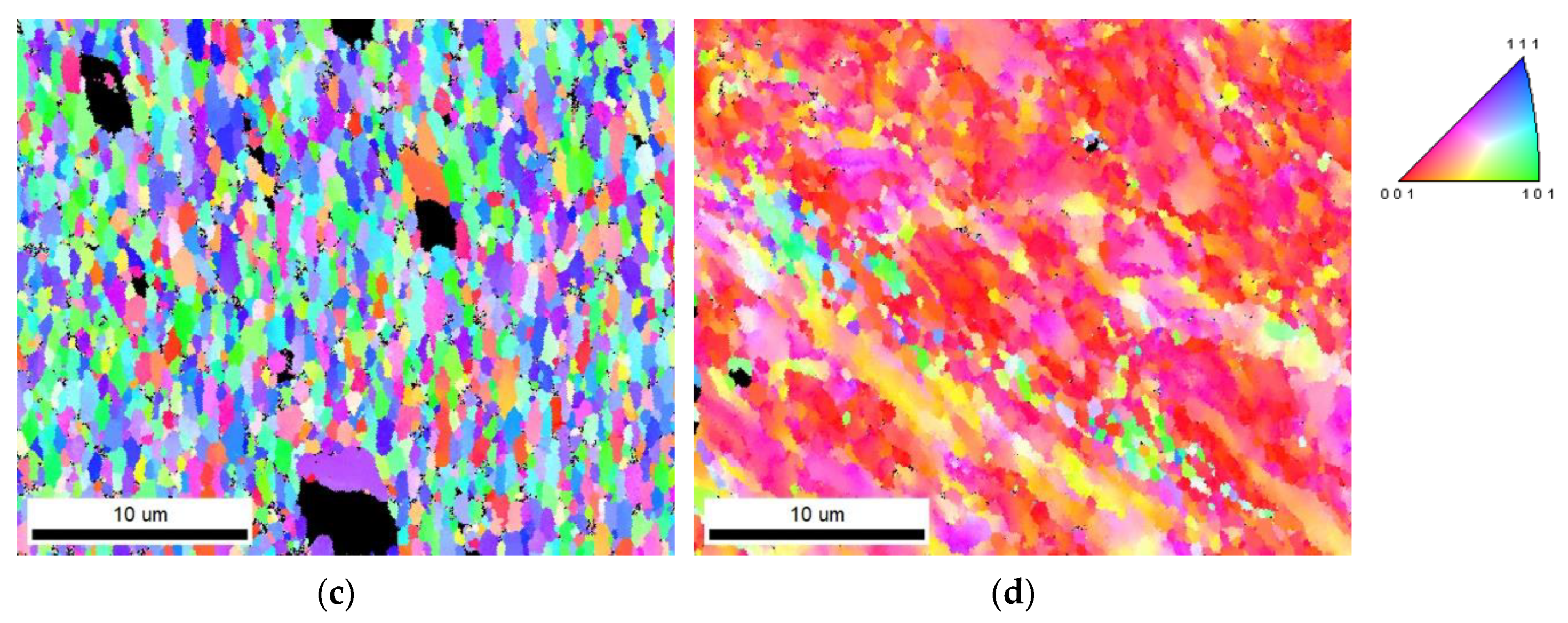

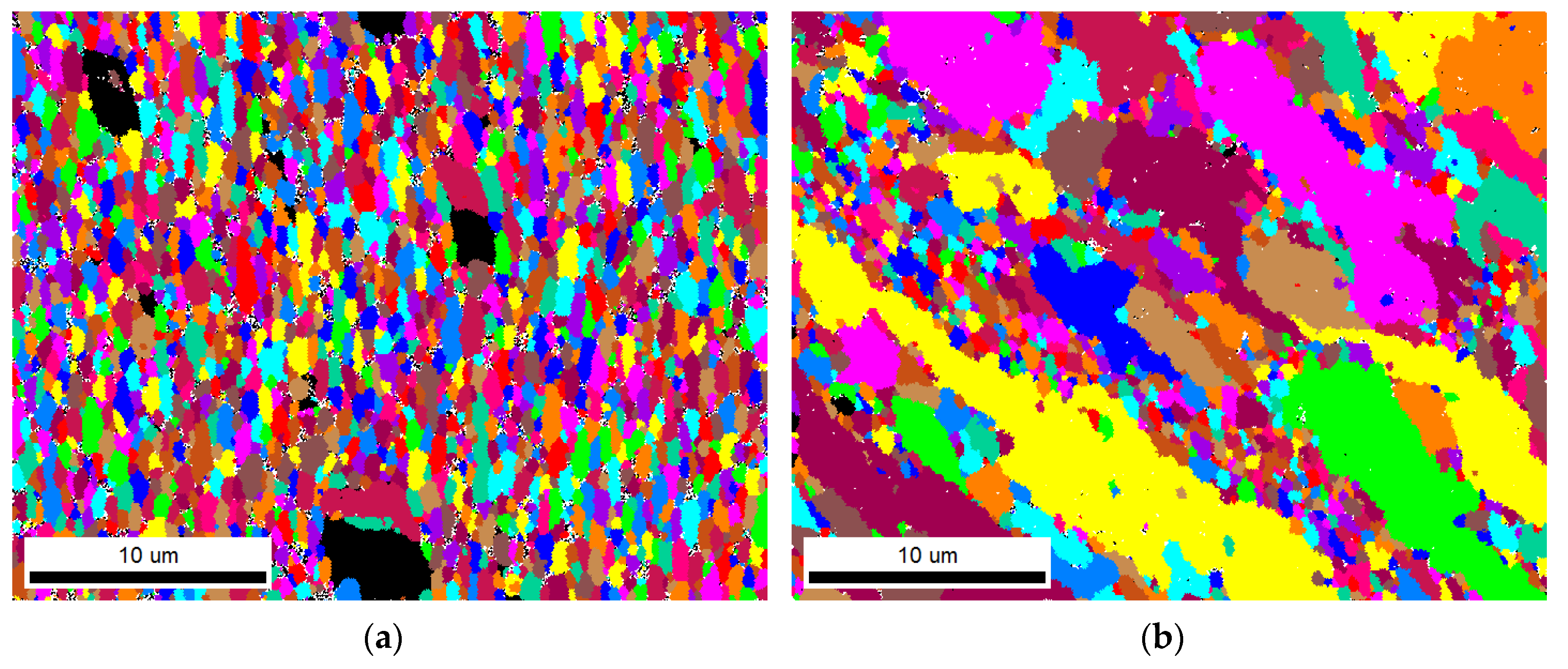
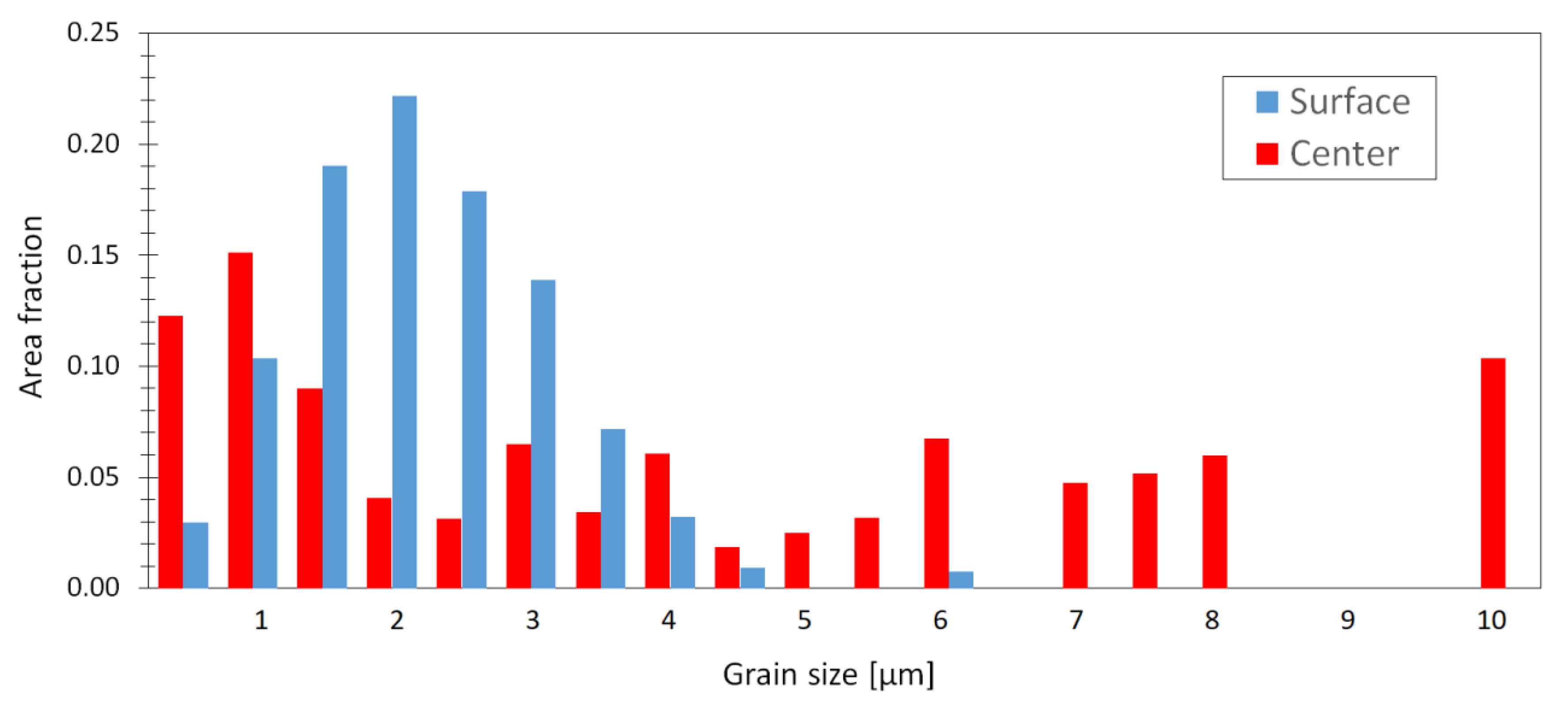



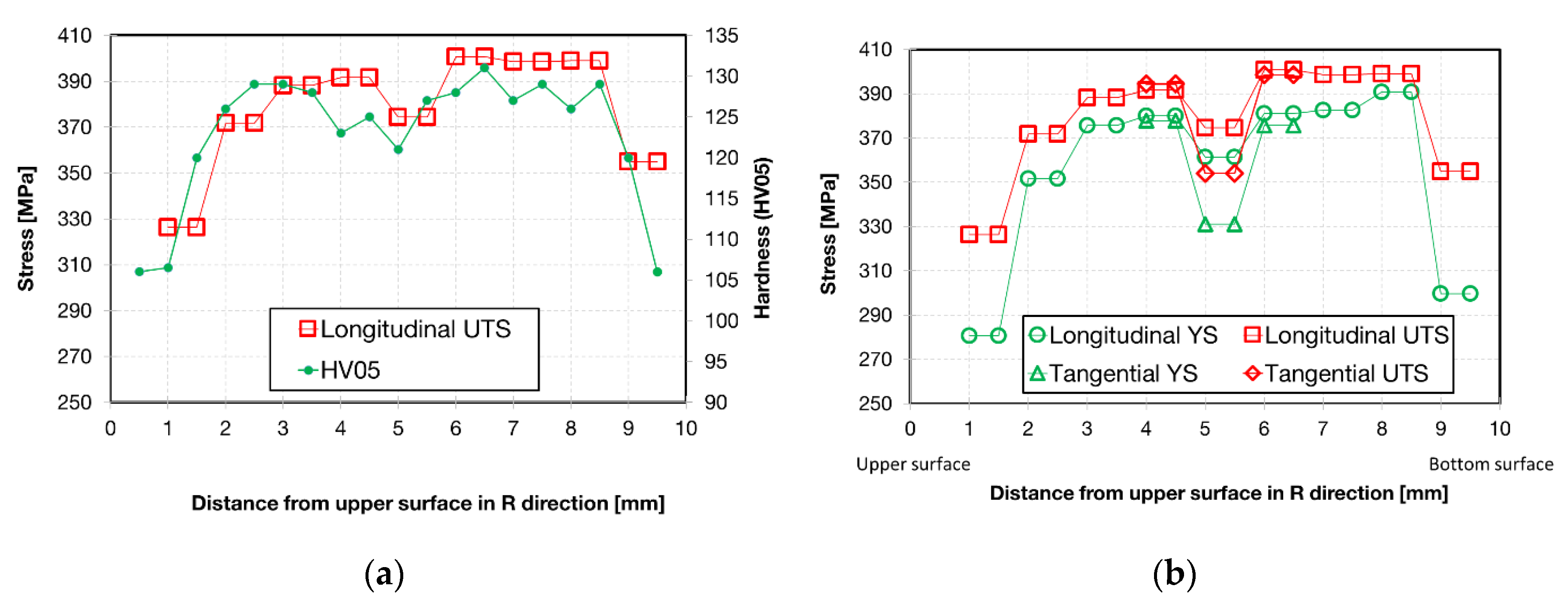
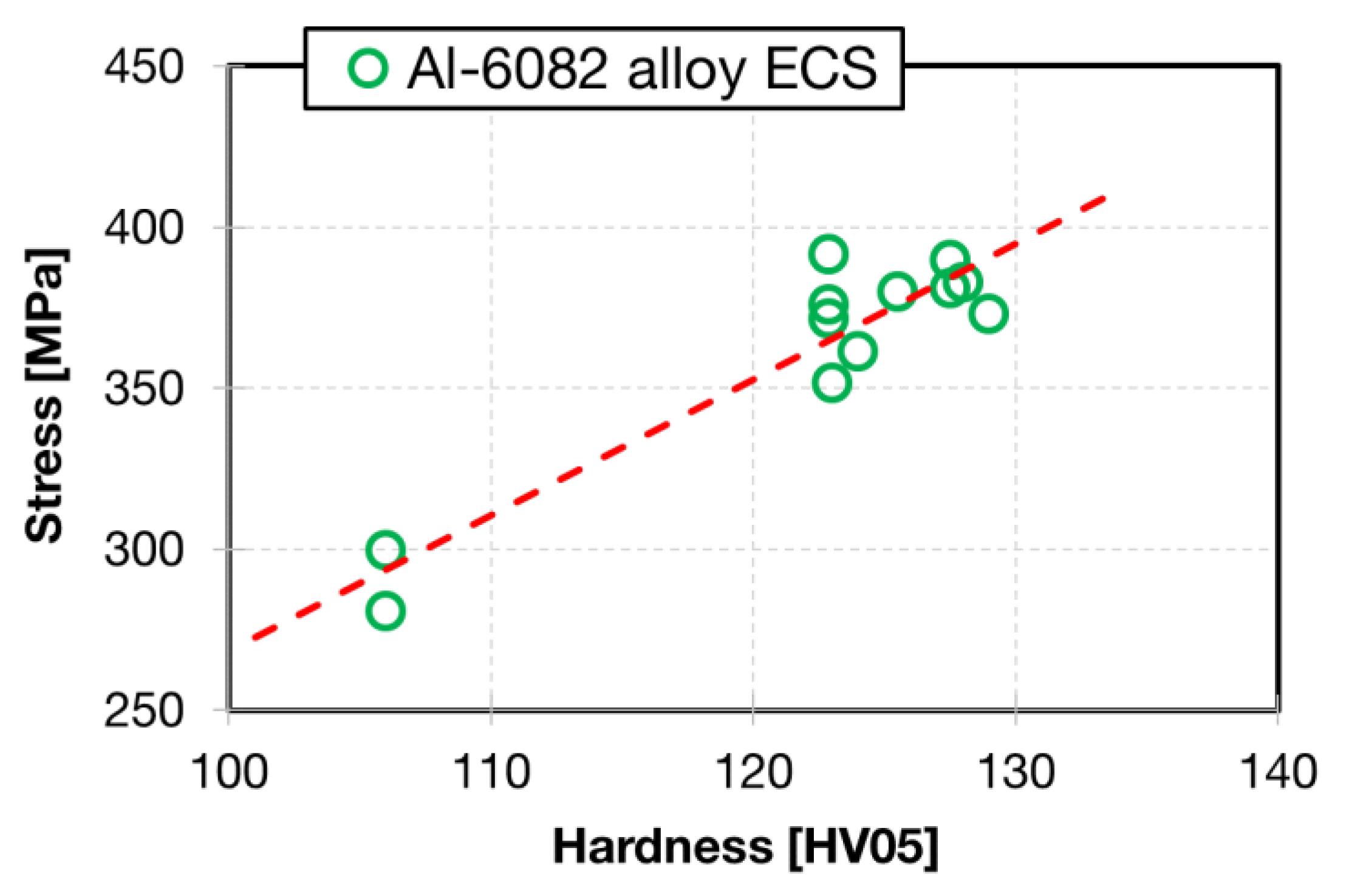
| Element | Si | Fe | Cu | Mn | Mg | Al |
|---|---|---|---|---|---|---|
| wt% | 0.91 | 0.43 | 0.05 | 0.85 | 1.15 | bal. |
© 2020 by the authors. Licensee MDPI, Basel, Switzerland. This article is an open access article distributed under the terms and conditions of the Creative Commons Attribution (CC BY) license (http://creativecommons.org/licenses/by/4.0/).
Share and Cite
Procházka, R.; Sláma, P.; Dlouhý, J.; Konopík, P.; Trojanová, Z. Local Mechanical Properties and Microstructure of EN AW 6082 Aluminium Alloy Processed via ECAP–Conform Technique. Materials 2020, 13, 2572. https://doi.org/10.3390/ma13112572
Procházka R, Sláma P, Dlouhý J, Konopík P, Trojanová Z. Local Mechanical Properties and Microstructure of EN AW 6082 Aluminium Alloy Processed via ECAP–Conform Technique. Materials. 2020; 13(11):2572. https://doi.org/10.3390/ma13112572
Chicago/Turabian StyleProcházka, Radek, Peter Sláma, Jaromír Dlouhý, Pavel Konopík, and Zuzanka Trojanová. 2020. "Local Mechanical Properties and Microstructure of EN AW 6082 Aluminium Alloy Processed via ECAP–Conform Technique" Materials 13, no. 11: 2572. https://doi.org/10.3390/ma13112572
APA StyleProcházka, R., Sláma, P., Dlouhý, J., Konopík, P., & Trojanová, Z. (2020). Local Mechanical Properties and Microstructure of EN AW 6082 Aluminium Alloy Processed via ECAP–Conform Technique. Materials, 13(11), 2572. https://doi.org/10.3390/ma13112572






